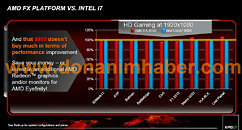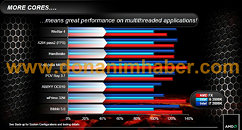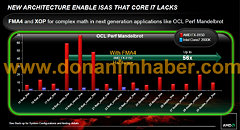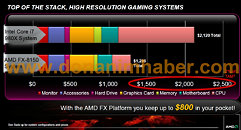Saturday, September 24th 2011

AMD FX 8150 Looks Core i7-980X and Core i7 2600K in the Eye: AMD Benchmarks
The bets are off, it looks like Intel is in for a price-performance shock with AMD's Bulldozer, after all. In the press deck of AMD FX Processor series leaked by DonanimHaber ahead of its launch, AMD claims huge performance leads over Intel. To sum it up, AMD claims that its AMD FX 8150 processor is looking Intel's Core i7-980X in the eye in game tests, even edging past it in some DirectX 11 titles.
It is performing on par with the Core i7-2600K in several popular CPU benchmarks such as WinRAR 4, X.264 pass 2, Handbrake, 7Zip, POV Ray 3.7, ABBYY OCR, wPrime 32M, and Bibble 5.0. AMD FX 8150 is claimed to be genuinely benefiting from the FMA4 instruction set that Sandy Bridge lacks, in the OCL Performance Mandelbrot test, the FX 8150 outperforms the i7-2600K by as much as 70%. Lastly, the pricing of the FX 8150 is confirmed to be around the $250 mark. Given this, and the fact that the Core i7-2600K is priced about $70 higher, Intel is in for a price-performance shock.
Source:
DonanimHaber
It is performing on par with the Core i7-2600K in several popular CPU benchmarks such as WinRAR 4, X.264 pass 2, Handbrake, 7Zip, POV Ray 3.7, ABBYY OCR, wPrime 32M, and Bibble 5.0. AMD FX 8150 is claimed to be genuinely benefiting from the FMA4 instruction set that Sandy Bridge lacks, in the OCL Performance Mandelbrot test, the FX 8150 outperforms the i7-2600K by as much as 70%. Lastly, the pricing of the FX 8150 is confirmed to be around the $250 mark. Given this, and the fact that the Core i7-2600K is priced about $70 higher, Intel is in for a price-performance shock.




854 Comments on AMD FX 8150 Looks Core i7-980X and Core i7 2600K in the Eye: AMD Benchmarks
end of story
With their GPUs, they're able to compare their next-gen with the competition's (Nvidia's) next-gen, or more obviously their current-gen is comparable to the competition's current-gen.
In the CPUs, they're essentially only making their next-gen comparable to the current-gen of the competition (Intel).
at least in the raw core performance
Although Nvidia wasn't quick as well with the 400 and 500 series, the "time-delay" between their and AMD's respective "current-gens" aren't as far apart as Bulldozer is to Sandy Bridge.
And as an additional point, with AMD comparing the FX 8150 to the Core i7-980X would be akin to Nvidia comparing the GTX 480 to the HD 4870X2, which they didn't do, unless you considering "HD 5870" as corresponding to "HD 4870X2"...
Don't worry it hardly shows...;)
2600k has extra decoders to help with threading (if I remember correctly).
It's about getting more threaded performance for the die space. In either case the better the program (important part here) is written for multi threading, the better performing the 2600k and the 8 core BD will be over the 2500k.
When it comes to performance over 2500k, then BD wins every time (if the price is correct which I'm not sure it is).While I agree on this (the performance part not so much the virtual core part), it also proves my point of multi thread processors need programs that take advantage of them or you end up with a CPU (AMD or Intel) that performs like a cheaper version.
The virtual cores don't really do a whole lot of work, the processor is still has 6 physical cores to do the work, and they can only do the work of 6 physical cores. No matter what it appears to the OS.
The BD chip doesn't go head to head with the 980x, it barely touches the 980x in multithreaded apps, and the 980x is a generation old. The BD really goes head to head with the 2600K for pretty much the same price.If you hadn't noticed, I do own an AMD rig(actually several, just only one in the 4 primary machines I use). And in the next few weeks I'll be replacing another one of my Intel rigs with an AMD because for what it is used for, AMD is a better buy.Really, because you pretty clear said:Your lack of knowledge on how HT works, and how closely the 2600K performs to the 2500K really shows. Even in the best coded multi-threaded apps, the 2600K only gets a relatively small boost thanks to HT.
If the price & perform is real , it will be a good CPU for the price IHO no matter how many cores it has
Sorry for poorly chosen words. My point was pointing out that saying that the 2600k is just a 4 core CPU is misleading since it can handle 8 threads. It is more then just a 4 core (4 core plus extra hardware) otherwise it would perform like the 2500k since it could only handle 4 threads like the 2500k.
I prefer to compare performance based on number of threads a CPU can handle. Cores are misleading (I think) because you leave out the ability of some CPUs to handle more threads (therefore) and allow them to perform better in certain circumstances.
Example:
If a program only does 4 threads, then both BD and 2600k look bad from an architecture and price standpoint (compared to a 2500k). The more threads the program can do, the greater the potential for BD and 2600k to distance themselves from the 2500k and provide a better price/performance. The closer the program relies on more actual "core hardware" the better the BD architecture should distance itself from SB. At this point, it really depends on how well the program is written to take advantage of the architecture. Lean either way (BD or SB) and one will perform better then the other.
If anything, I hope this will drive down Intel's 32nm Westmere prices so I can move up to a 6 core 1366 CPU for even less. That's my hope.
Going by all the information AMD has released they really are just dual threaded cores with enough extra non shared hardware that AMD felt it suitable to market as separate cores thus some people think each "core" should be better than they are.
What makes me laugh though is that when it comes to average consumers the whole 8 core thing will go down well and lend it's self great to marketing use so as far as mass market goes it will probably be a good thing but it's the people who should know better that just can't seam to accept the architecture for what it is.
Far as i know a virtual core is about 25% of a normal cores performance, it mimics the core.
Well we dont know that with 100% as none of the tests show that, only against he 2600K and it wins half losses half.
We need some better benches to see how it realy all turns out. So far im happy been a AMD user i can now get a CPU upgrade to be on par with others from the other camp for cheaper, win win for me.
i think thats what i've seen people argue about a few times now
4 module, each module has 2 integer core, and each integer core has its own L1 data cache, integer scheduler and integer datapath, while sharing L2 and L3 cache between integer core in one module.
This is the best die shot I have on BD architecture:
Competes with
Haswell(2013) -> Haswell(2013) -> Haswell(2013)
and 8-cores Sandy Bridge-EP vs 16-core Interlagos
Interlagos wins the price and power brackets at being $1400~ below and below 150~ watts while maintaining Intel's $5000 and above performance bracket
Server market is much more diluted than the Desktop market
---
Also, these benchmarks/demos weren't done by AMD...just telling
Oh and lets not forget, that AMD also uses higher clock speeds, so that means more cores with higher clocks, for less performance. Well done AMD.:shadedshu
Regardless of what i said above, these news completely acceptable by me, since this is how i hoped the BD (this FX-8150) will fair out. Now the only thing left to know is how it'll run when paired with C5F, Sabertooth 990FX or any other 990FX/X-based mobo, 2x4GB DDR3 1600MHz RAM, 2xGTX 4xx/5xx or 2xHD 6xxx, 1kW+ PSU & fast HDD or SSD & tested here. If you'll pit it (FX-8150) gainst both 990X & 2600K - ace. :toast:
P.S. Is there a CPU-based Photoshop benchie to test multithreading? I might check this one out once i'll buy this CPU; probably end of October/middle of November.
Anyway, BD has to be better than Phenom II x6 otherwise what's the purpose? It's 315 mm2 die size compared to Sandy's 216 mm2 (on which we also have an IGP) should provide some performance, isn't it?